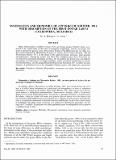Por favor, use este identificador para citar o enlazar a este item:
http://hdl.handle.net/10261/174563COMPARTIR / EXPORTAR:
 SHARE
BASE SHARE
BASE
|
|
| Visualizar otros formatos: MARC | Dublin Core | RDF | ORE | MODS | METS | DIDL | DATACITE | |

| Título: | Systematics and bionomics of Physomeloe Reitter, 1911, with description of the first instar larva (Coleoptera, Meloidae) |
Autor: | Bologna, M.A.; Aloisi, G. | Palabras clave: | Coleoptera Meloidae Physomeloe Nuevo taxon New taxon |
Fecha de publicación: | 25-may-1994 | Editor: | CSIC - Museo Nacional de Ciencias Naturales (MNCN) | Citación: | Eos : revista española de entomología 69(1): 45-56 (1993) | Resumen: | [EN] Meloe (Physomeloe) corallifer Germar, 1818, an Iberian species of blister beetle, is referred
to the Lyttini tribe on the basis of triungulin morphology, and the monotypic subgenus
is elevated to generic status. Physomeloe Reitter, 1911 differs from the two other wingless
and brachyelytrous Mediterranean genera of Lyttini, Berberomeloe Bologna, 1988 ami
Trichomeloe Reitter, 1911, in the shape of the adult pronotum, antennae, male genitalia
and pubescence. Among the Lyttini, only these three wingless genera have first instar larvae
with well sclerotized abdominal sternites, but in addition the dorsal setae and abdominal
spiracle I in Physomeloe are highly modified. Adult and larval morphology are described
and illustrated, and the geographical distribution and bionomics of P. corallifer are summarized.
A preliminary key to the triungulin of lyttine genera and subgenera is proposed. [ES] Se atribuye Meloe (Physomeloe) corallifer Germar, 1818, una especie ibérica de carraleja, a la tribu Lyttini basándose en la morfología del triungulino y se eleva el subgénero monotípico a la categoría de género. Physomeloe Reitter, 1911 difiere de los otros dos géneros ápteros y braquelitros mediterráneos, Berberomeloe Bologna, 1988 y Trichomeloe Reitter, 1911, por la forma del pronoto, las antenas, la genitalia masculina y la pubescencia del adulto. Entre los Lyttini, sólo estos tres géneros ápteros tienen larvas de primera fase con esternitos abdominales bien esclerotizados, pero, además, en Physomeloe las sedas dorsales y el espiráculo abdominal I están fuertemente modificados. Se describe e ilustra tanto la morfología del adulto como la larvaria y se comenta la distribución geográfica y la biología de P. corallifer. Se propone una clave preliminar para los triungulinos de los géneros y subgéneros de Lyttini. |
URI: | http://hdl.handle.net/10261/174563 |
| Aparece en las colecciones: | (MNCN) Eos, Revista Española de Entomología |
Ficheros en este ítem:
| Fichero | Descripción | Tamaño | Formato | |
|---|---|---|---|---|
| 1993-69-001-007.pdf | 13,64 MB | Adobe PDF |  Visualizar/Abrir |
CORE Recommender
Page view(s)
237
checked on 18-abr-2024
Download(s)
182
checked on 18-abr-2024
Google ScholarTM
Check
NOTA: Los ítems de Digital.CSIC están protegidos por copyright, con todos los derechos reservados, a menos que se indique lo contrario.
